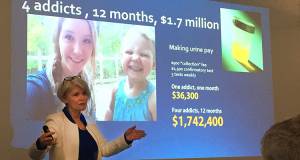New York – Pat Beall said she and her colleagues at The Palm Beach Post had been consistently reporting on Palm Beach County’s growing opioid epidemic, highlighting the lives of a few of the victims and the toll their death took on families and the larger community. But it wasn’t enough. Each story would get a little attention, but within a day or two the latest victim would be all but forgotten.
“This was a situation where every other day in Donald Trump’s Palm Beach back yard someone was dying a heroin-related death and, literally, no one cared,” Beall said quietly.
So the award-winning investigative reporter and her colleagues began compiling the names, faces and stories of all 216 people who died of heroin overdoses in Palm Beach County during 2015. They dug through public records, scoured Facebook pages, contacted families, crunched numbers and late last year published “Heroin, Killer of A Generation.” The project, which includes a picture and profiles of each victim, made an immediate impact both locally and across the nation, prompting promises of action by Palm Beach County officials.

Photo by Karen Savage
Palm Beach Post reporter Pat Beall shares the lessons learned in covering the opioid epidemic in Palm Beach County, Florida.
Now Beall is sharing what she’s learned about the crisis with journalists from across the country.
“I think that it’s a very competitive business, but I think journalism works best — particularly when it comes to matters of public concern — when there’s connection and shared information,” said Beall.
Beall was one of nearly 100 journalists and experts who attended “Covering the Opioid Crisis” a Poynter Institute workshop on March 3, 2017, designed to help journalists better cover the unfolding crisis.
Each day in the United States, 44 people die as a result of prescription opioid overdose. Others lose access to prescription drugs and turn to heroin. The free workshop, hosted by RetroReport and sponsored by Blue Cross Blue Shield Association, brought together front-edge experts to offer journalists the latest information on the crisis, including updates from medical doctors, insurance providers and colleagues who have reported on the epidemic.
“I hope that people can kind of use it as a springboard and take whatever I have and mold it to their own purposes,” said Beall, who said she hopes journalists at the workshop will be able to replicate her reporting in their own communities.
“This is a huge, huge issue — it’s so much bigger that the Post could be doing or any group of papers in Florida could be doing,” she added.
Daniel Hilferty is the president and CEO of Independence Blue Cross and has met with both President Obama and President Trump regarding national health care policy. Hilferty said media coverage of the opioid crisis has forced insurers, providers and pharmaceutical companies to limit the amount of opioids that doctors prescribe to patients after medical procedures, and the coverage is fueling continuing discussions on the epidemic.
“It all started because of the press,” Hilferty said, motioning to the audience. “That’s why what we’re doing here today is so important.”
“The opioid crisis is a huge story in its own way and part of the bigger story of building a sustainable health care system,” he said. “Last fall a CDC study found that opioid abuse cost the American economy $78.5 billion per year and that includes about $28 bill in direct health care costs.”
Beall said she found the economic impact in Palm Beach County to be a staggering $1.1 billion in just the first nine months of 2015 — which comes to about $4 million per day. She offered to share her team’s methodology with reporters interested in calculating the cost in other communities.
“It’s not just overdose deaths,” she said. “If you’re only looking at heroin overdose cases, we are really missing a chunk of the cost of the actual epidemic.”
Hilferty said many who received substance abuse treatment could not have done so without the Affordable Care Act, and he said allowing individuals under 26 to remain covered by their parents’ insurance has been particularly beneficial to young people struggling with addiction, a success story he said hopes reporters will continue to cover.
“That is concrete evidence that the next round of reform, whichever shape it takes — and I think at this point it’s anybody’s guess — should preserve the gains in coverage,” Hilferty said, adding that 20 million people who were not covered for substance abuse treatment prior to the Affordable Care Act are now covered.
Emily Feinstein, director of health law and policy at the National Center on Addiction and Substance Abuse, urged reporters to ask tough questions about health care reform.
“America doesn’t understand it, people writing the plans don’t understand it,” Feinstein said.
“Don’t be afraid to ask and really drill down into how is this making a difference? Can people afford care, are people getting care, are people getting better,” she said.
Al Tompkins, senior faculty member at The Poynter Institute, said it’s important to cover what communities are doing to to address the epidemic.
“The City of Baltimore, while being the center of a huge problem, is a city that’s not standing still on this,” said Tompkins, who moderated the workshop. “With all they’ve done, it hasn’t stopped the problem,” he said. “But they’re not doing nothing, they’re trying all sorts of things.”
Mike O’Brien is the director of opioid prevention and treatment for the City of Baltimore, where overdose deaths have grown from 167 in 2011 to 393 in 2015. Final data for 2016 is not yet available, but preliminary data indicates the final total could reach more than 650.
“It means that in our city, every single day, there’s a newly empty seat at somebody’s dinner table,” said O’Brien.
In spite of the skyrocketing numbers, Baltimore has been recognized nationally for having an aggressive response to the crisis. O’Brien said the city’s three-pronged response includes offering education, expanding access to treatment and training residents to use naloxone, a prescription drug that can stop an overdose on heroin, OxyContin and other opioids.
“You literally use it (naloxone) like a nasal spray — you stick it in somebody’s nose, you push the button, and the medication is injected into their nose and absorbed the nasal membranes,” O’Brien said.
“We believe it should be part of every single medicine cabinet,” he said, adding that everyone in the city is encouraged to complete a training program and pick up a prescription for the medication.
Since 2015, more than 20,000 Baltimore residents have been trained and more than 800 life-saving doses of naloxone have been administered.
O’Brien said that’s still not enough.
“The single biggest limiting factor on our ability to do more is that the price for naloxone has skyrocketed in recent years,” he said, urging reporters take a deeper look at the price increase.
“To me this is a critically important story that should be told over and over, because this medication is available for pennies in other countries,” he added.
O’Brien told journalists it’s important to include success stories in their coverage.
“This is a tough issue right now, people are dying,” he said. “But another huge part of this is to shine a light on people who have been able to find recovery. It’s a chronic disease and not everyone gets healthy right away. But people do recover, treatment does work, and those stories can be really beautiful to hear.”
He also implored journalists to carefully consider the language they use to describe opioid users and the stigma associated with the disease.
“We have to stop calling people addicts — these are people with a health disorder,” O’Brien said. “It’s a really loaded way of describing people that, for a lot of the people that may be reading or hearing your message, does carry that kind of loaded moral judgment that I don’t think should be part of a health care disorder.”
Beall said her team in Palm Beach County came to believe that stigma is one of the most lethal elements of the crisis. She said she and her team at the Post agonized for weeks about whether to use victims’ full names and pictures. Ultimately, they concluded they had to include the information. (Read more about the development of the project.)
“We believed that if we were to take photos out based on fear of stigma, that we would be participating in the stigma,” Beall said, adding that the decision to use the photos wasn’t made until just days before publication.
She said getting to know all of the 216 victims’ stories took a toll on her personally.
“It’s fair to say that I’m haunted, but I think that’s kind of an appropriate reaction. I think I’d rather be a little haunted,” she said, adding that she still keeps the double truck and the front page on the wall in her work space.
When Tompkins asked why she does that, Beall paused.
“I don’t know,” she said quietly. “They just matter, they really mattered, and they still do, and I like to be reminded of that.”






